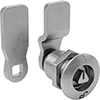Filter by
Latching Distance
Mounting Location
Overall Length
Weight Capacity
Strike Plate Material
Draw Latch Type
Finish
Height
Ball Material
Overall Width
Latching Distance Adjustability
Width
Body Material
Export Control Classification Number (ECCN)
DFARS Specialty Metals
Building and Machinery Hardware
Fabricating and Machining































